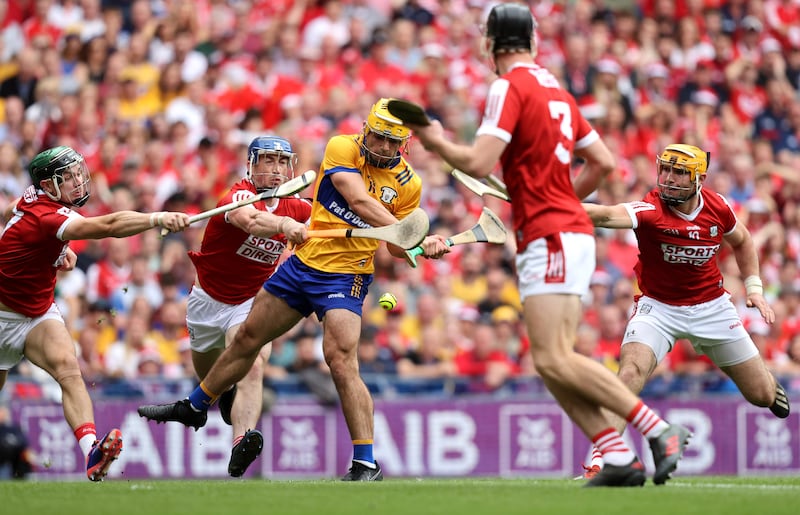The report of a long dead committee is like a message in a bottle. At their press conference last Wednesday, the latest Hurling Development Committee said they had read the work of ancestral committees in their family tree. In their due diligence they will have seen the passionate proposals of sincere people desperate to cause change.
Establishing how many of those proposals made a difference through the decades would be a vast scoping exercise. But in their reading, they must have been struck by the echo chamber and the hand-me-down chorus of giving out and exasperated finger-pointing.
The McNamee Report of 1971, with its tangerine cover and 330 pages of text – equally Irish and English – is the Book of Kells in the canon of GAA reports. Seven pages are devoted to hurling, including 11 earnest recommendations and suggested cures.
All these years later, some of the aspirational stuff is dispiriting to read. In 1964, the GAA had formed what it called a Hurling Scheme. One of its declared aims was that hurling would be played in every parish by 1984, the GAA’s Centenary Year. How did that end up? No spoiler alerts are necessary.
Twenty years was an extraordinarily long life expectancy for any project, especially in a volunteer setting, so their work was split into five-year tranches. One of the things they did immediately was grade the counties, like spuds: nine were deemed to be “strong” hurling counties; seven were regarded as “average”; 16 were “weak” or “very weak”.
If those gradings were applied now would the numbers be any different? Were there nine “strong” counties in the Liam MacCarthy Cup this year? At most, 10.
The McNamee report suggested six “basic requirements” for the future success of the Hurling Scheme. The first was “enthusiasm for and commitment to the game at all levels”.
It sounds like a pat requirement, but hurling has never been able to depend on broad base “enthusiasm” or “commitment”. The game is showered in bouquets when a spectacular match pops up on television and hundreds of thousands of people who have no day-to-day interaction with hurling are swept along, like the boozy last dance at a wedding.
A parish-by-parish census of sports clubs would be interesting now, because 60 years ago, when the Hurling Scheme started, there would have been more hurling teams in rural Ireland than soccer teams. That balance has flipped, emphatically.
It is not difficult to see why: soccer, and Gaelic football, are not hard for beginners; hurling is. Reaching a level of proficiency where hurling can be rewarding to play takes more time and a higher threshold for practice and disappointment. In the Age of Instant Gratification that is a harder sell.
Through the decades, the fretting and the hand-wringing never ceased. In 1994, 30 years after the birth of the Hurling Scheme, Nickey Brennan stood up at GAA Congress and said hurling was “in crisis”. Brennan, who would later become president of the GAA, had been part of the Hurling Revival Sub Committee.

That committee’s report makes for grim reading now. Among their headline conclusions was that “there had been a noticeable fall off in standards, even in the so called stronger hurling counties”. They also said that hurling in the weaker counties was only surviving due to “the heroic efforts of a couple of individuals. It is clear too that many of these people are almost at breaking point”.
As part of the committee’s work, a detailed questionnaire was sent to every county board; six counties ignored it. In the appendix to the report the offending counties were named: Louth, Meath, Dublin, Wexford, Laois and Waterford, four of whom would have been regarded as elite hurling counties. It accidentally clarified the greatest threat to hurling: inertia.
When it came to the promotion of the game, though, nobody has ever been led by the nose. Nobody was ever shamed into it. The late Séamus McGrattan was Ulster GAA’s first hurling development officer, and asked about spreading hurling in south Armagh in the early 1990s he said he would have had a better chance of “promoting cricket”.
Over the years, the agonised introspection has continued. The Hurling 2020 report, led by the former Tipperary manager Liam Sheedy and published nine years ago, was not short on rebuke. “As an organisation which aims to promote hurling and football equally” it read, “we have been doing the game of hurling an injustice for a long time”.
For hurling, anger has never moved the dial or softened resistance in parts of the country where it was entrenched. Hurling is prone to a persecution complex, but that has never helped either.
At the press conference last Tuesday, Terry Neill, chair of the Hurling Development Committee, spoke about acts of “sabotage” by county boards against hurling. It was the same phrase that Martin Fogarty had used in an interview when he was Director of Hurling. “The only language that people understand is money,” he said. “I have told them [the leadership in Croke Park] that the only way to stop the sabotage [by Gaelic football clubs] is to pull the funding.”
As a promotional tactic, coercion would stand no chance. The new Hurling Development Committee are acutely aware of the challenges they face, and their thinking is not clouded by any romantic notions.
At elite level, the game is gripped in a boom. Over the last 10 years, seven different counties have contested at least two All-Ireland finals; eight different counties have contested at least two provincial finals; six different counties have reached at least two Division One league finals. As a game, hurling has never been more spectacular.
This committee, though, must target small and meaningful wins. In their PowerPoint presentation on Wednesday, they outlined their intention “to develop a toolkit, based on best practices, to promote hurling in communities”. That is the way forward.
This is a ground war. The challenge will be to identity places and people who want hurling to be part of their communities and shower them with support and resources. There is no future in trying to impose hurling on anybody. People must want it. They must have a feeling for it.
On Wednesday, the HDC didn’t make any outlandish promises. That is a good start.

















